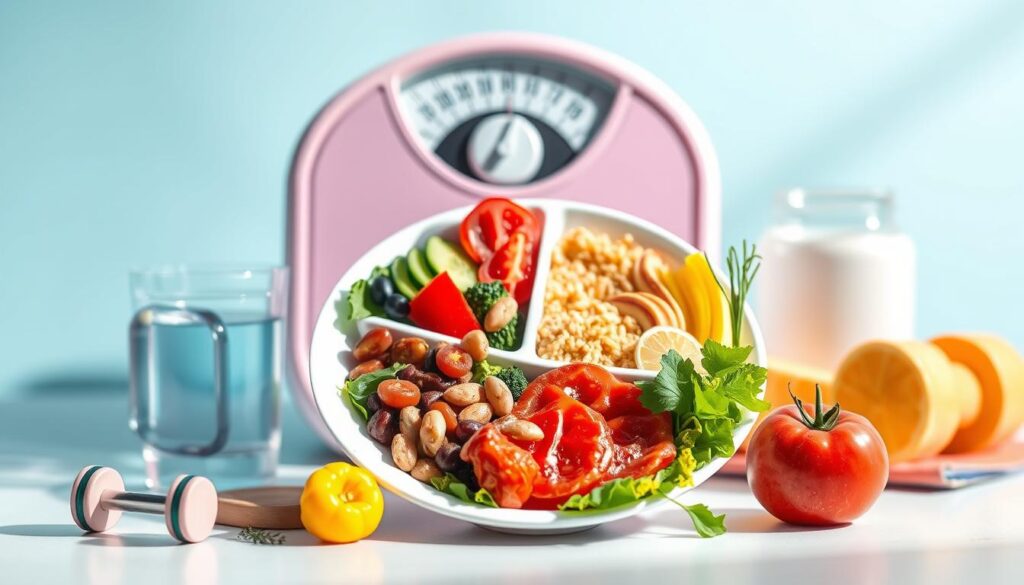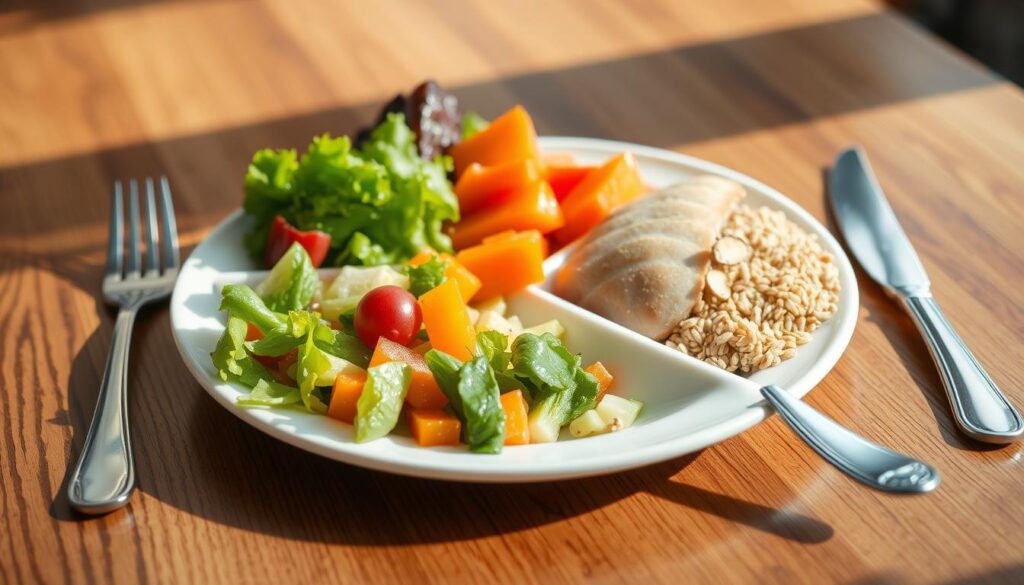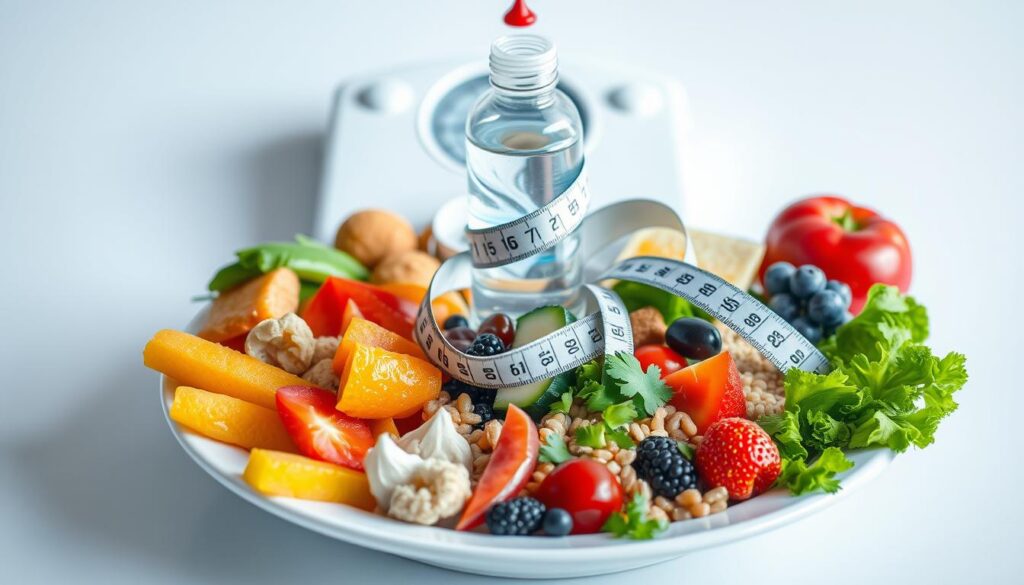Starting a weight loss journey is both exciting and scary. It’s key to set goals that are doable and healthy. Knowing how many calories you need each day helps. This way, you can lose weight slowly and safely.
The National Heart, Lung, and Blood Institute (NHLBI) says start with 5-10% of your current weight. The Centers for Disease Control and Prevention (CDC) agrees. Setting clear goals helps you stay on track and keep going.
Key Takeaways
- Aim for a weight loss goal of 5-10% of your current weight for sustainable results.
- Create a moderate calorie deficit of 500-750 calories per day to lose 1-2 pounds per week.
- Focus on improving your overall health and fitness, not just the numbers on the scale.
- Consult with a healthcare professional to determine your personalized calorie needs and safe weight loss plan.
- Incorporate physical activity and make gradual, sustainable dietary changes for long-term success.
Understanding the Basics of Weight Loss Calorie Goal
Getting to a healthy weight is all about finding the right calorie balance. Your daily calorie needs depend on your age, gender, weight, height, and how active you are. Knowing these factors is key to setting a good weight loss calorie goal.
What Determines Your Daily Calorie Needs
Your Basal Metabolic Rate (BMR) is how many calories your body needs to stay alive when you’re not moving. This is a big part of how many calories you burn every day. Also, how active you are affects how many calories you need.
The Science Behind Caloric Deficit
To lose weight, you must eat fewer calories than your body burns. Aim for a deficit of 500 to 1,000 calories a day. This can help you lose 0.5 to 1 pound a week. Losing weight slowly is better for keeping it off.
Role of BMR in Weight Management
Your BMR is the base of your calorie needs. Knowing it helps you make a good weight loss plan. By figuring out your BMR and activity level, you can find out how many calories you need each day. A healthy metabolism booster is key for keeping weight off for good.
| Age | Recommended Daily Calorie Intake (Females) | Recommended Daily Calorie Intake (Males) |
|---|---|---|
| 2-3 years | 1,000 – 1,400 | 1,000 – 1,400 |
| 4-8 years | 1,200 – 1,800 | 1,600 – 2,000 |
| 9-13 years | 1,400 – 2,200 | 1,600 – 2,600 |
| 14-18 years | 1,800 – 2,400 | 2,000 – 3,200 |
| 19-30 years | 1,600 – 2,400 | 2,200 – 3,200 |
| 31-50 years | 1,600 – 2,200 | 2,200 – 3,000 |
| 51+ years | 1,600 – 2,200 | 2,000 – 3,000 |
These are just general guidelines. Your calorie needs can change based on your activity, metabolism, and health. Talking to a doctor or dietitian can help find the right calorie goal for your and .
Why Traditional Diets Often Fail
Traditional diets often cut calories too much and remove whole food groups. This isn’t good for keeping weight off. Instead, make lasting changes to how you eat and think about weight.
Traditional diets can make you feel tired, hungry, and want to eat more. They don’t work for everyone because they don’t consider personal needs. Everyone is different, and diets should be too.
Medically supervised weight loss programs are better. They are watched by doctors to make sure you’re doing well. They teach you to eat better, exercise, and change your life for good.
These programs also use special medicines like Semaglutide to help control hunger. They help with health problems that might stop you from losing weight. This way, you can keep the weight off for a long time.
It’s also bad to eat most calories at night. It can slow down your metabolism and mess with your blood sugar. Eat well and use portion control and intermittent fasting to help you lose weight.
“Nearly half of Americans have attempted weight loss in the past year, but only 15-20% of those who lose weight are able to keep it off.”
By making lasting changes and getting help that fits you, you can beat the cycle of bad diets. You can keep your weight off for good.
Creating Your Personalized Calorie Target
To reach your weight loss goals, you need a personal calorie target. First, find out how many calories you burn daily. Then, decide how many calories you want to cut. Lastly, think about how active you are. This way, you can make a plan that helps you lose weight in a healthy way.
Calculating Your Maintenance Calories
Your maintenance calories are how many calories you need to stay the same weight. You can use the Mifflin St. Jeor equation for this. It looks at your age, gender, weight, and height.
For men, it’s (10 x weight in kg) + (6.25 x height in cm) – (5 x age in years) + 5. Women use (10 x weight in kg) + (6.25 x height in cm) – (5 x age in years) – 161.
Determining Your Ideal Deficit
After finding your maintenance calories, figure out your calorie deficit. Aim for 500-750 calories less each day. This helps you lose 1-2 pounds a week, which is good.
But don’t cut too many calories. Women should not go below 1,200 calories a day. Men should not go below 1,400 calories a day. Cutting too many calories can harm your health.
Adjusting for Activity Level
Your activity level affects how many calories you need. The Dietary Guidelines for Americans give multipliers for this:
- Sedentary: Maintenance calories x 1.2
- Lightly Active: Maintenance calories x 1.375
- Moderately Active: Maintenance calories x 1.55
- Very Active: Maintenance calories x 1.725
- Extremely Active: Maintenance calories x 1.9
By knowing your BMR and activity level, you can find your weight loss calorie goal. This helps you succeed in losing weight for the long term.
“A healthy weight loss goal is not to exceed a loss of 2 pounds of fat per week, which requires a daily calorie deficit of 1,000 calories.”
Smart Goal Setting for Sustainable Weight Loss
Setting goals for weight loss is key for lasting success. It’s better to aim for SMART goals. These goals should be specific, meaningful, action-based, realistic, and timely. They should focus on making lasting changes in your behavior.
Try setting goals around eating the right portions and moving more. For example, add one more serving of fruits or veggies to your meals. Or, walk for 30 minutes every day, five times a week. Goals like these can lead to better weight loss than just focusing on a number.
Experts say to lose 1-2 pounds a week or 4-8 pounds a month. Losing weight slowly is better than quick diets. Quick diets often lead to weight gain back.
After losing weight for about 6 months, think about keeping it off. This helps you keep up the good habits you’ve learned. It makes sure your weight loss stays off for good.

Remember, losing weight is not just about the number on the scale. It’s about living a healthy life. By setting SMART goals and making slow, lasting changes, you can lose weight and stay healthy for the future.
Essential Tools for Tracking Your Progress
Successful weight loss is about making lasting changes. You need the right tools to track your progress. Tools like calorie counting apps and measurement methods help you stay on track.
Best Apps for Calorie Counting
Apps like MyFitnessPal are great for tracking calories. It has over 3.7 million 5-star reviews. It lets you log foods and track your progress easily.
These apps also offer tips on diet and exercise. They help you make smart choices for lasting weight loss.
Methods for Measuring Success
Don’t just look at the scale. Track your body measurements and clothing size too. Progress photos can also show your success.
Keeping a journal helps you understand your mood and energy. Joining a weight loss group or seeing a doctor can also help.
| App | Key Features | User Ratings |
|---|---|---|
| MyFitnessPal | Extensive food database, calorie and macronutrient tracking, activity integration, premium features | 4.8 (iOS), 4.6 (Android) |
| Lose It! | Personalized calorie recommendations, meal planning, barcode scanning, progress tracking | 4.7 (iOS), 4.5 (Android) |
| FatSecret | Free calorie counter, food diary, exercise log, weight chart, community support | 4.4 (iOS), 4.2 (Android) |
Developing Healthy Eating Patterns
Getting to a healthy weight is more than just portion control and counting calories. It’s about making healthy eating a part of your life. Eating small meals every 3-4 hours helps keep your blood sugar steady and controls portion sizes.
Mindful eating is key for managing weight. Listen to your body’s hunger signals and don’t eat out of habit or emotion. Eat foods rich in nutrients like fruits, veggies, whole grains, and lean proteins. This way, you fuel your body right.
Planning meals ahead can stop you from making bad food choices. It helps you prepare healthy meals for when you’re busy. Setting aside time for meal prep can help you reach your fat burning diet goals.

“Developing healthy eating patterns is the key to sustainable weight loss. It’s not just about cutting calories, but about nourishing your body with the right foods and creating a balanced lifestyle.”
Remember, losing weight is a journey, not a quick fix. By making these habits part of your daily life, you’ll get closer to a healthier relationship with food. And you’ll reach your wellness goals in the long run.
The Role of Macronutrients in Weight Loss
Macronutrients like proteins, carbs, and fats are key for losing weight. Knowing how to use them right can help you reach your goals. It also keeps you healthy and happy.
Protein Requirements
Protein is important for keeping muscles strong and feeling full. This is good for losing weight. Eat 1.2–2 grams of protein for every kilogram of your weight. Studies show this helps with losing weight and keeping muscles.
Carbohydrate Balance
Carbs give us energy. Choose complex carbs for better energy and health. The ketogenic diet limits carbs to 10% of calories. But, the Dietary Guidelines say 45–65% of calories should be carbs.
Healthy Fat Integration
Healthy fats like olive oil, avocados, and nuts make us feel full. They also give us important fats. Eat 10–30% of your calories from healthy fats. Try to keep saturated fats under 10%.
Tracking macronutrients helps make a weight loss plan that works for you. It keeps you healthy and happy.
| Macronutrient | Calories per Gram | Recommended Intake |
|---|---|---|
| Protein | 4 calories | 10-35% of daily calories |
| Carbohydrates | 4 calories | 45-65% of daily calories |
| Fats | 9 calories | 20-35% of daily calories |
Incorporating Physical Activity
Regular physical activity is key for lasting weight loss. The American Heart Association says adults should do at least 150 minutes of moderate activity weekly. They also suggest muscle-strengthening activities two days a week.
This activity helps you lose weight and improves your health and metabolism. It’s important to find activities you enjoy. This could be dancing, hiking, or joining a fun run.
Make exercise fun and engaging. This way, you’ll keep doing it. If you need to, break your exercise into smaller parts. Make sure you do at least 10 minutes of moderate effort at a time.
As you get fitter, increase the intensity and time of your workouts. Any movement helps with weight loss and health. Keep your body active and engaged. An exercise routine is a great metabolism booster for reaching your weight loss goals.


A Life-Changing Experience with This Weight Loss Supplement (Nagano Tonic)
I’ve always struggled with finding a weight loss solution that actually works for me. Like many, I’ve tried numerous diets, exercise routines, and supplements over the years—some worked for a short time, but nothing ever gave me long-term results. That was until I decided to try the weight loss supplement I found : Link to the Supplement.
From the moment I started using it, I noticed a difference. Not only did I feel more energized, but my cravings also became more manageable. The best part? I started seeing results much quicker than I anticipated! Over the course of just a few weeks, I noticed a significant reduction in belly fat and overall weight loss that I hadn’t been able to achieve before.
What makes this supplement stand out from all the others I’ve tried is how it supports me in my daily routine without any jitters or energy crashes. I’m able to stay focused and motivated, which has made it easier to stay on track with my diet and exercise plan.
This product truly exceeded my expectations, and I feel more confident and healthier than ever before. If you’re struggling with your weight loss journey like I was, I highly recommend giving this supplement a try. It’s been a game-changer for me, and I’m sure it can work wonders for you too!
Contant Them on email .. tonicnagano50@gmail.com
I’ve tried so many weight loss products over the years, but nothing worked like this supplement! Since I started using it, I’ve noticed a big difference in my energy levels and appetite control. In just a few weeks, I’ve lost weight and feel so much better. It’s been easy to stick with, and the results speak for themselves. Highly recommend this to anyone looking to make a real change!
wasn’t sure what to expect, but this weight loss supplement has really impressed me! After just a few weeks of use, I’ve already dropped a few pounds and feel more motivated to stay active. It’s helped curb my cravings and boosted my energy throughout the day. I’m excited to keep going and see even better results. Definitely worth trying!
Reach them on tonicnagano50@gmail.com
I was skeptical at first, but this supplement has truly made a difference in my weight loss journey. I’ve lost weight without feeling deprived or sluggish. My cravings are under control, and I feel more confident in my body. It’s easy to incorporate into my daily routine, and the results speak for themselves. I’m so glad I gave it a try!
Thanks David, i do use the link to make my purchase. you can get too here http://surl.li/iasppy
I’ve tried so many weight loss products, but this one has been by far the most effective. In just a few weeks, I’ve noticed a visible difference in my body and energy levels. It’s helped me stay on track without the constant hunger pangs and cravings. I’m really happy with my progress and can’t wait to see where I’ll be in another month!
This Nagano Tonic has been amazing! In just a few weeks, I’ve lost weight, feel more energized, and my cravings are under control. Highly recommend it!
Thats the link to purchase http://surl.li/iasppy